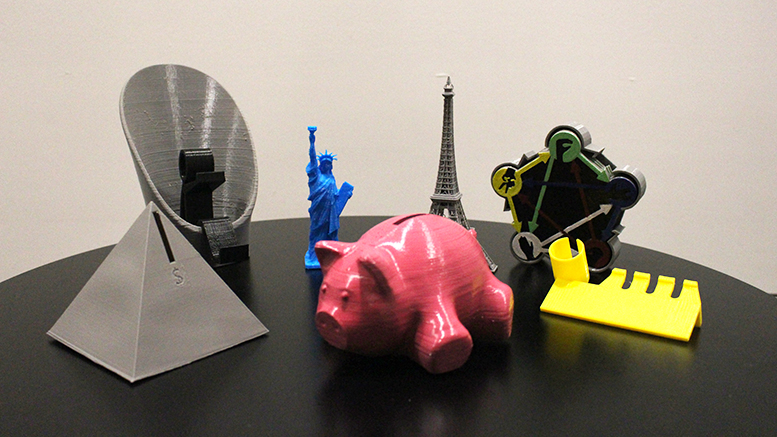The skills needed for accounting and 3D printing originate in opposite sides of the brain.
3D printing is a creative pursuit. You need the inspiration and vision to develop an item, quite literally, from the bottom up.
Accounting is rooted in mathematical logic – addition and subtraction, dollars and cents.
It wouldn’t seem likely for the two fields of study to cross paths. But that is exactly what is happening this semester at Cuyahoga Community College’s Westshore Campus and Corporate College West.
Students in Eric Primuth’s management accounting class are taking on a project that requires them to engage both the left and right sides of their brains. Each student must develop the concept for an item that can be produced via 3D printing – also called additive manufacturing. At the same time, students must create a plan for how that product can be mass-produced – including sourcing of raw materials, production costs, packaging and shipping.
Each student must then build a prototype of the item using the 3D printers available at Westshore and Corporate College West.
Planting the idea
Primuth first became interested in incorporating 3D printing into his management accounting curriculum through the Ohio Means Internships & Co-ops (OMIC) program at Cleveland State University.
“I was one of the OMIC externs, and MAGNET (the Manufacturing Advocacy & Growth Network) is a partner of OMIC,” Primuth said. “Dave Pierson, a senior engineer at MAGNET and part-time instructor at Tri-C, gave a presentation on additive manufacturing, and it really opened my eyes as to what the technology can do.”
Exposing students to that technology is one of the main goals of the 3D printing project. With the continuing advancement of additive manufacturing as a viable path to production and profit, businesspeople of the future will need to understand how an additive manufacturing business model must operate in order to be successful.
Business and accounting students who aren’t exposed to additive manufacturing are going to find themselves at a disadvantage as they enter the business world.
“The goal of the project is threefold,” Primuth said. “One, to give the students hands-on experience in developing and costing a product from start to finish. Two, to expose them to additive manufacturing terminology and techniques. Three, to get them thinking about sustainability, which is one of the main draws of additive manufacturing in the business world.”
Partnering on the project
To help create the project, Primuth worked with Gary Arnosk, an integration technician at the Westshore Campus. Arnosk provides students with background on additive manufacturing technology, how a 3D printer and printing software works, and what types of items can be produced in a 3D printer.
In early October, Primuth and Arnosk met with the fall 2017 management accounting class at the 3D printing lab at Corporate College West. The fall 2017 class will be the third to tackle the project.
The purpose of the meeting was to give students a crash course in the what, how and where of 3D printing. Primuth passed around examples of items produced by students in previous classes.
They look simple – a cellphone holder, a set of coasters, a scale-model Eiffel Tower and Statue of Liberty – but each required hours of planning and printing, and every hour spent on an item comes with a cost.
“To design something that can be 3D printed, there is a lot you have to understand first,” Arnosk said. “You have to understand the capabilities and limitations of the printers. You have to understand how much plastic you’re going to have to use. And things don’t always turn out right the first time. If something turned out right, it’s probably because there were prior attempts where the calibration was off, the design was off, or something else went wrong.”
Every move of the machine has to be determined in advance, and it can take thousands of nearly microscopic injections of melted plastic to make a finished product over the span of hours. A design mistake might not become apparent until many hours into the project.
“For example, a horizontal arm or appendage needs to be supported as it’s being printed,” Arnosk said. “You have to decide whether it makes more sense to print a temporary support that you can then cut away once the piece is complete, or to maybe print the object on its side so the arm prints vertically.”
Exploring potential
With the technology still in its infancy, the teachers are learning along with the students. The outcome of each project offers additional insight into the possibilities of additive manufacturing.
“It’s interesting, something different that we don’t normally get to do,” said student Genavieve Maheu. “It’s a unique way to show the entire process of how you build and cost something.”
“It’s something that I think is truly unique for a class like this,” Primuth said. “It’s taking an emerging technology that these students will probably encounter in their careers and allowing them to work with it while they’re still in school. I don’t think there are many other non-manufacturing classes doing things like this.”

